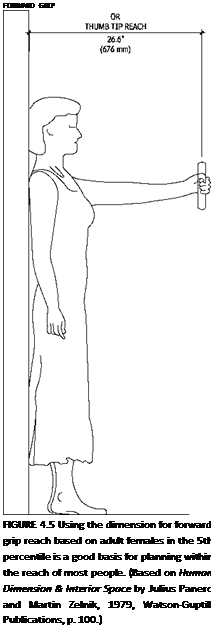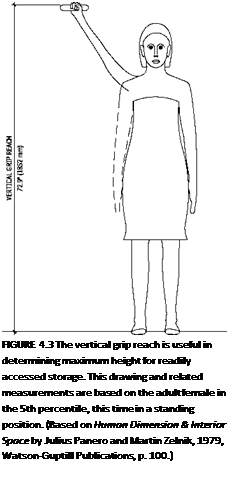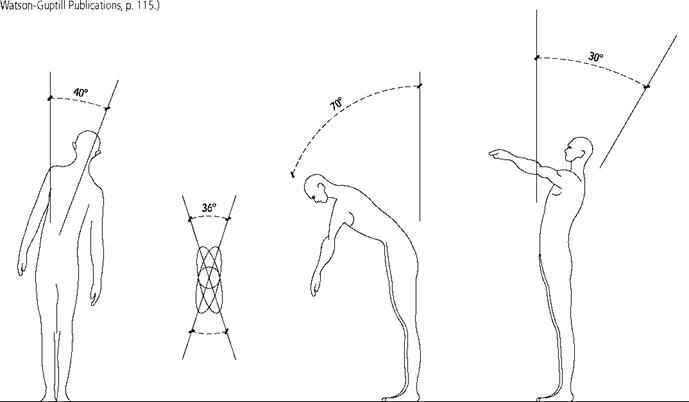Functional anthropometry, also referred to as dynamic anthropometry, is the measurement of the body in motion. It includes movement of body parts in relationship to one another and measures of strength. Because it is more complex, it is more difficult to accurately measure. However, certain measurements are very helpful to bathroom planning, mainly the reach range and the functional space of a person using a variety of mobility aids.
• Vertical reach height sitting (see Figure 4.2) is the height above the sitting surface of the tip of the middle finger when the arm, hand, and fingers are extended vertically. It impacts general overhead, and shower and bathtub controls, as well as storage.
• Vertical grip reach (see Figure 4.3) is the distance from the floor to the top of a bar grasped in the hand, raised as high as it can without discomfort, while the subject stands erect. It is important in planning the height of bookshelves, storage shelves, or controls. Vertical grip reach from a seated position is also important in design that accommodates operating from a seated position.
• Side arm grip reach (see Figure 4.4) is the distance from the centerline of the body to the outside surface of a bar grasped in the hand, stretched horizontally without experiencing discomfort or strain, while the subject stands erect. This measurement helps determine a comfortable height for fixture controls and general storage. There seems to be more information available on this dimension for a standing person, but the data and its application involve the seated user as well.
•
 |
 |
Forward grip reach or thumb tip reach (see Figure 4.5) is the distance to the tip of the thumb measured with the subject’s shoulders against the wall, with the arm extended forward and index finger touching the tip of the thumb. This dimension influences depth and height of work counters and shelves above the counters as well as general storage.
 |
 |
 |
Height and Reach Ranges
Height and reach ranges vary according to stature, physical ability, and obstructions. The height
range within a person’s reach is useful for planning functional storage, fixtures, fittings, and controls in the bathroom.
• The lower end of a forward reach range is 15 inches to 24 inches (381 mm to 610 mm) off the floor, depending on a person’s ability to bend. The upper length can go as high as 72 inches (1823 mm), depending on a person’s stature and any obstruction, such as a counter or shelf.
• The average person who remains seated to maneuver in the bathroom has a forward reach range of 15 inches to 48 inches (381 mm to 1219 mm).
• A standing person who has difficulty bending may have a forward reach range of 24 inches to 72 inches (610 mm to 1823 mm).
• People who use crutches, walkers, or in some way needs their hands to maintain balance, have a slightly different reach range, depending on their mobility aid and physical ability.
|
TABLE 4.1 Working with the Functional Dimensions and Reach Ranges of a Variety of People, Universal Design Proponents Use the Universal Reach Range to Accommodate Most People
|
Combining these reach ranges with the functional limits of reaching over a 25-inch (635-mm) – deep counter, a universal reach range of 1 5 inches to 48 inches (381 mm to 1219 mm) has been suggested. This range is generally accepted and used to guide placement of storage, controls, and more.
Range-of-Joint Motion
Range-of-joint motion is another aspect of human dimension that obviously impacts the design of the space and components within a bathroom. These include: movements of the hands, wrists, and fingers; movement and flexibility of the shoulders and elbows; bending or twisting at the waist or spine; and movement of the knees (see Figure 4.6). Because no joint operates in isolation, it is difficult to generate accurate and useful information regarding range of motion of joints. However, understanding the areas to consider will help in developing a space that works for a specific client. FIGURE 4.6 A person s range of motion in the |f you can observe and estimate a client’s range-of-joint motion, your design and specifications can
spine and sh°ulders can impact the appropriate more accurately meet the client’s needs.
size of a shower and location of its fittings.
(Based on Human Dimension & Interior Space by Julius Panero and Martin Zelnik, 1979,
|
LATERAL ROTATION FLEXION HYPEREXTENSION BENDING |




